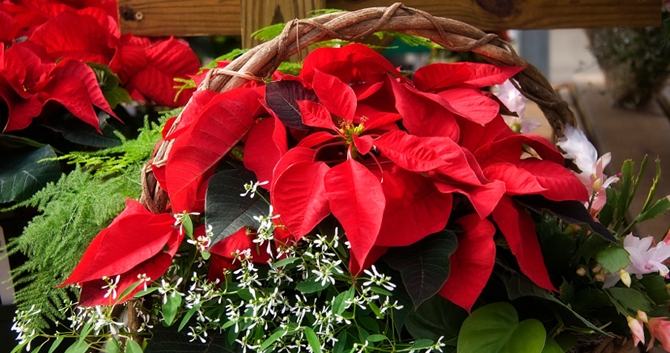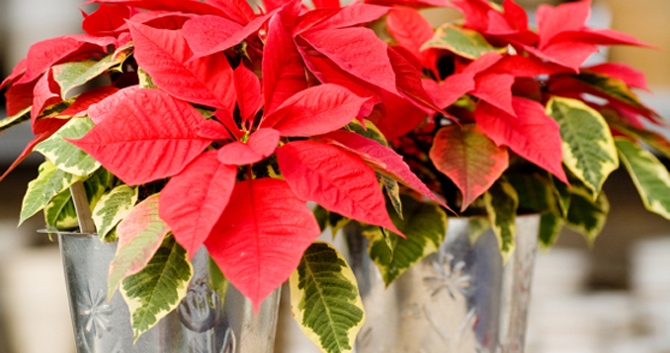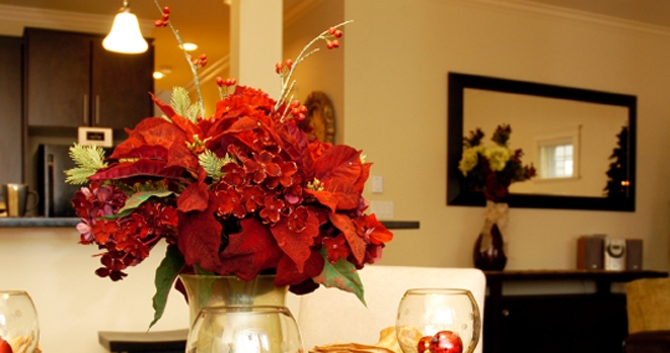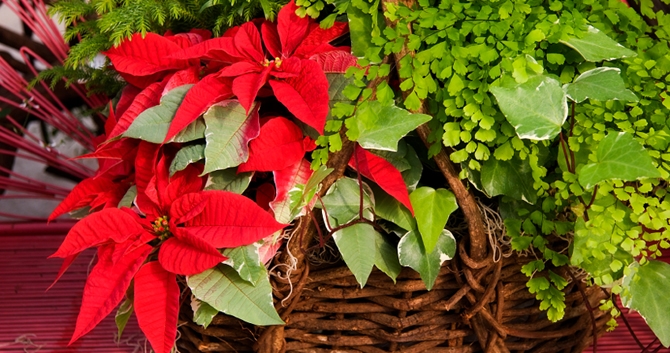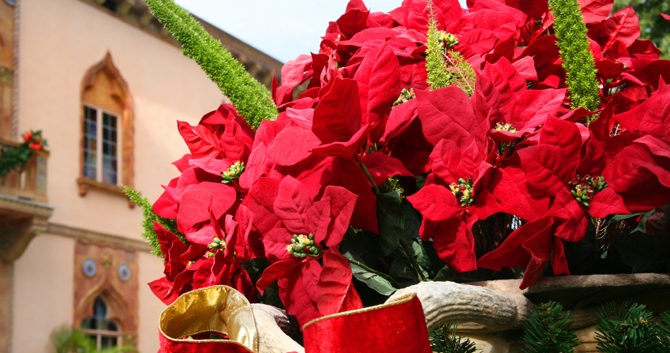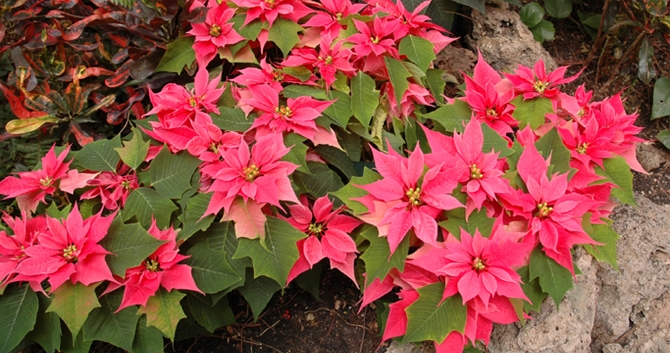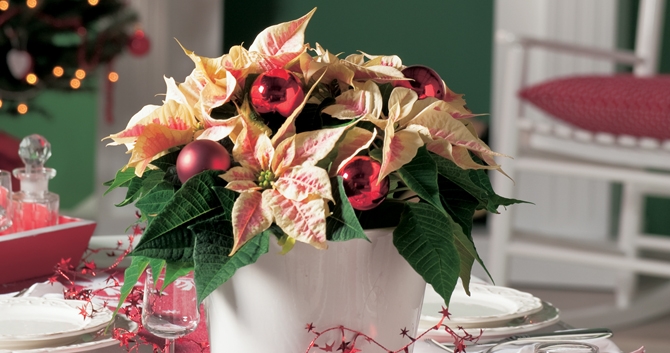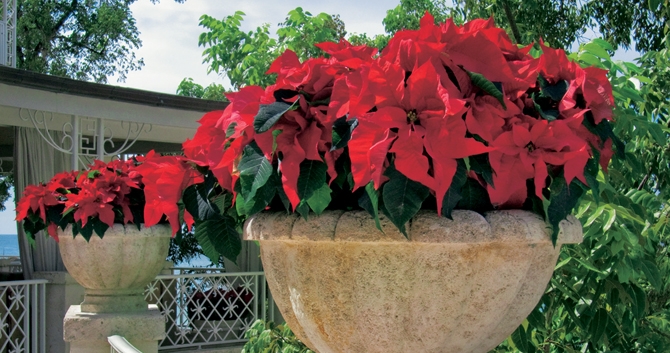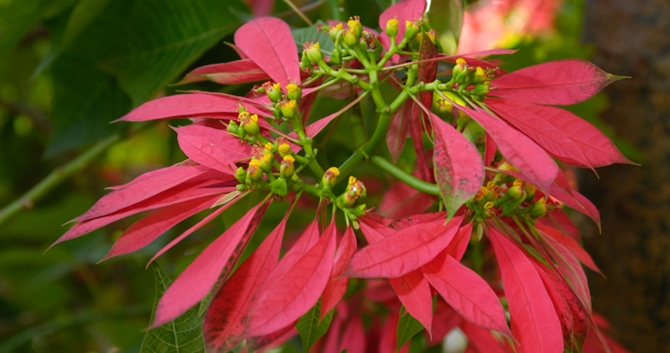Poinsettias are the little black dress of holiday decorating, an effortless way to transform your décor from Thanksgiving through the New Year with vibrant colors of crimson, orange, pale green, cream, pink, and white in solid shades or marbled hues. Dramatic and long lasting, poinsettias are the iconic holiday flower. Along with holly, mistletoe, evergreens, and pine cones they stir anticipation and excitement for the season.
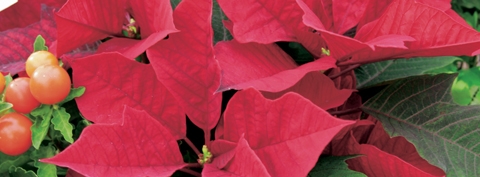 Poinsettias are the little black dress of holiday decorating
Poinsettias are the little black dress of holiday decorating
Poinsettias are native to the mountains of Southern Mexico, where they cover the steep slopes around Taxco del Alarcon with vibrant red blooms during the winter months. Prized by the Aztecs as a symbol of purity, they were transported in caravans to Mexico City to adorn the courts of Montezuma, dye textiles, and cure fevers.
Later incorporated by Franciscan missionaries in 17th century nativity processions, poinsettias became inextricably linked with Christmas celebrations. Their allure spread to the US in 1826 after they were discovered growing wild along the side of the road by the first US Ambassador to the Mexico, Joel Roberts Poinsett.
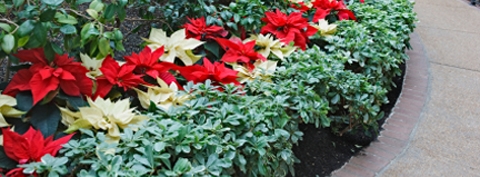 Mix poinsettias with existing plantings to spruce up a garden bed
Mix poinsettias with existing plantings to spruce up a garden bed
Botanists chose the name Euphorbia pulcherrima, or most beautiful euphorbia. As the plants became popular, they were given the common name of poinsettia to honor Poinsett’s legacy. What we think of as flowers are actually leaves (or bracts) that surround a contrasting yellow cluster of true flowers. The bracts turn from green to red in the winter months after spending weeks in 12 hours of total darkness each day.
Selecting Plants
When selecting poinsettias, check the branches, flowers, and bracts to be sure you get the freshest plant that will last throughout the holidays:
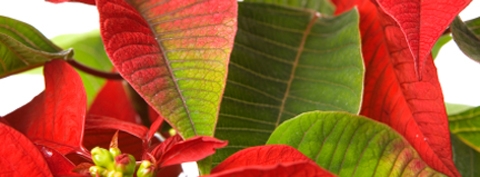 When selecting poinsettias, avoid greening bracts as their color will fade more quickly
When selecting poinsettias, avoid greening bracts as their color will fade more quickly
- Be sure there are no broken branches or cracked stems being held together by the plant sleeve. If you happen to get home with a damaged stem, don’t worry as it can be repurposed in a cut flower arrangement.
- Look for tight unopened yellow buds in the center of the bracts and be sure there are no missing center flowers. Plants with these qualities are the freshest will last longest.
- Avoid greening bracts. If the bracts are beginning to turn green, the plant is older and won’t retain its color as long.
Care Tips
In the wild, poinsettias thrive on steep slopes in misty mountain air. In the home, they are happiest when kept in a warm spot away from drafts, watered modestly, and misted regularly. They can be planted outside in warmer regions where temperatures are consistently above 60oF but should be kept indoors in colder areas.
Indoors or out, with minimal care your poinsettia will stay healthy and vibrant throughout the holiday season, lasting on average 2 to 4 weeks:
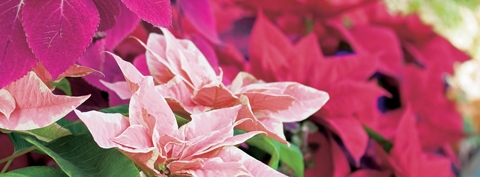 Poinsettia combine beautifully with coleus to create a monochromatic display
Poinsettia combine beautifully with coleus to create a monochromatic display
- Getting them Home: Unless temperatures are mild (above 60oF), poinsettias need some protection when getting them home from the store. The protective sleeve should shield them from the cold – just be sure not to leave them sitting in a cold car for a long time. Once home, remove the plastic sleeve so that plant will get needed air circulation. Conceal the plastic pot and protect the table by dropping them into a decorate pot.
- Light: Poinsettias prefer bright indirect light during the winter flowering season. Keep them in a sunny spot where they’ll get at least 6 hours of sunlight.
- Water: Only water poinsettias when the soil is slightly dry to the touch. Add water to soil surface until it just begins to trickle out drainage holes. Let the water drain thoroughly before returning them to the decorative pot or table.
- Mist: Poinsettias like humidity so mist them periodically.
- Fertilizer: There’s no need to fertilize poinsettias during the holiday season.
- Location: Avoid drafty, cold locations near doors or under vents where cold air can blow directly on the plant.
Troubleshooting
Poinsettias will let you know if they are unhappy. Even though you may only plan to keep them around during the holidays, it’s good to know how to correct a problem.
Withering: Yellowing or brown leaves are generally signs the air is too dry. Try misting the plants to rehydrate the bracts.
Wilting: If your plant starts wilting and dropping leaves, there is either too much or too little water.
Leaf Drop: Poinsettias will drop healthy leaves if there’s a draft or too little light. Relocate the plant to correct the problem.
After the holidays
Poinsettias are perennials that will rebloom every year so it’s tempting to hold onto them after the holidays. There are two schools of thought on this. Some say it’s not worth the time and attention - commercially grown varieties are very affordable and superior in size and shape to last year’s resurrected plants.
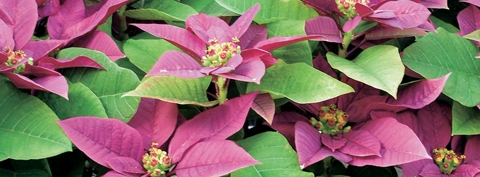 Poinsettia come in range of colors from red and orange to pinks, mauves, and white
Poinsettia come in range of colors from red and orange to pinks, mauves, and white
Others like a challenge, and follow these steps to maintain the plant and condition it to rebloom the following year:
- Winter: Poinsettias need time to go dormant and will drop their leaves toward the end of the bloom season. Water only once a month during this period.
- Early Spring: Prune the plant back to just the healthiest few green branches and repot into a slightly larger container. Place near a sunny window, keep the soil moist but not soggy, and mist regularly. When new growth begins, fertilize every few weeks with balanced indoor plant food.
- Summer: When the weather warms up, plants can be moved outside to a spot with indirect light. Indoors or out, continue to water, feed, and mist regularly throughout the summer. Shape the plant as it grows by pinching back shoots to force it to get bushier. Without maintenance, poinsettias tend to become leggy and unruly.
- Fall: Two months before you want blooms, initiate the color change. Poinsettias need two months with 12 hours per day of total darkness to rebloom. Put the plant in a dark closet each night, then bring it into indirect light during the day. Water when soil surface is dry to the touch and continue to feed regularly.

